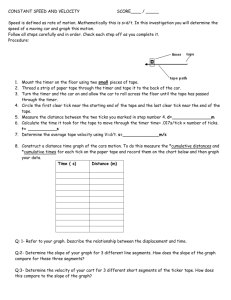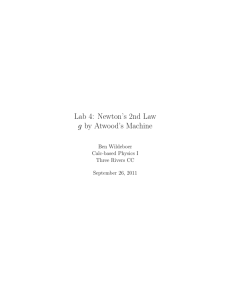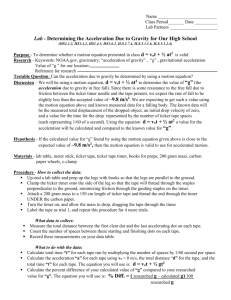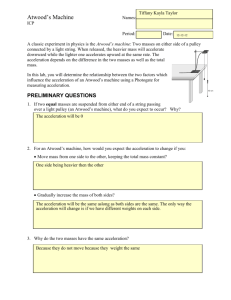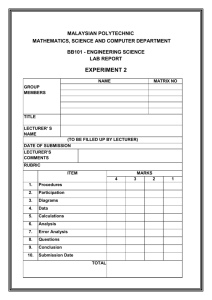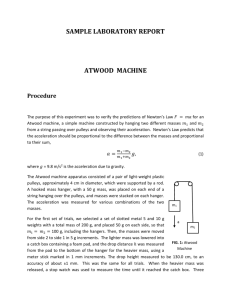Atwoodlab3
advertisement
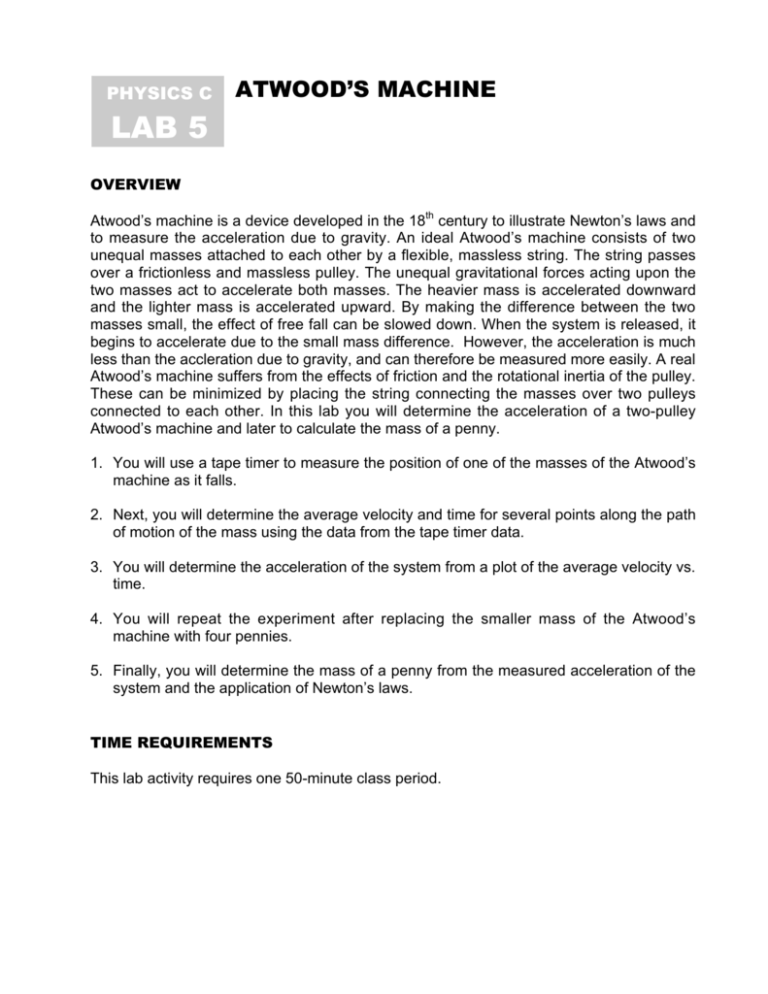
PHYSICS C ATWOOD’S MACHINE LAB 5 OVERVIEW Atwood’s machine is a device developed in the 18th century to illustrate Newton’s laws and to measure the acceleration due to gravity. An ideal Atwood’s machine consists of two unequal masses attached to each other by a flexible, massless string. The string passes over a frictionless and massless pulley. The unequal gravitational forces acting upon the two masses act to accelerate both masses. The heavier mass is accelerated downward and the lighter mass is accelerated upward. By making the difference between the two masses small, the effect of free fall can be slowed down. When the system is released, it begins to accelerate due to the small mass difference. However, the acceleration is much less than the accleration due to gravity, and can therefore be measured more easily. A real Atwood’s machine suffers from the effects of friction and the rotational inertia of the pulley. These can be minimized by placing the string connecting the masses over two pulleys connected to each other. In this lab you will determine the acceleration of a two-pulley Atwood’s machine and later to calculate the mass of a penny. 1. You will use a tape timer to measure the position of one of the masses of the Atwood’s machine as it falls. 2. Next, you will determine the average velocity and time for several points along the path of motion of the mass using the data from the tape timer data. 3. You will determine the acceleration of the system from a plot of the average velocity vs. time. 4. You will repeat the experiment after replacing the smaller mass of the Atwood’s machine with four pennies. 5. Finally, you will determine the mass of a penny from the measured acceleration of the system and the application of Newton’s laws. TIME REQUIREMENTS This lab activity requires one 50-minute class period. LAB 5 LAB EQUIPMENT AND MATERIALS A list of equipment and materials needed to perform this lab is given below. Equipment pulley, Atwood’s Machine (e.g., PASCO SA-9241) mass set, 5-100 g (e.g., PASCO ME-9348) balance (triple beam type, e.g., Fisher 02-034) tape timer (e.g., PASCO ME-9283) support stand, with 1/2” rod (e.g., PASCO ME-9355) rod clamp (e.g., Fisher 05-754) meter stick U.S. penny, post-1983 Materials timing paper, roll (for timer, e.g., PASCO ME-9284) carbon paper, disc (for timer, e.g., PASCO ME-9284) battery, 9 V. (for timer) string graph paper, linear Amount Needed 1 1 1 1 1 1 1 4 Amount Needed 1 1 1 2m 1 sheet/student LAB PROCEDURE Hints for a successful lab: fi Pennies minted before 1983 are more massive than newer pennies, so be sure the four pennies are from the same “era”. fi Do not use the dark dots at the very beginning or end of the tape, or any nearby dots. fi Be sure to use only dots that clearly show acceleration, i.e., dots that get successively further apart. Prepare the Atwood’s machine 1. Mount the two-pulley Atwood’s machine to to the support stand as high as possible. 2. Attach two mass hangers to the ends of the string and place the string over the pulleys. 3. Choose the large mass in the range of 200-500 g and the small mass as 10 g and attach the masses to the hangers. Prepare the timer 1. Attach the tape timer to the support stand above the heavy mass. 2. Check that the timer has a carbon disk mounted on it for recording to the paper tape. LAB 5 3. Set the tape timer to the 10 Hz (10 cycles/s) setting. Run the machine 1. Thread the timing tape through the tape timer and attach it to the heavy weight. 2. Raise the heavy weight as high as possible. 3. Turn on the tape timer. 4. Release the heavy mass. 5. Turn off the timer after the heavy mass stops falling. 6. Remove the paper tape from the mass and check that it has a series of dots on the tape. The distance between dots should increase along the tape. 7. Replace the small mass with four pennies and repeat the experiment. Perform calculations and record the data 1. Weigh the four pennies on a balance and record on the data sheet. 2. Measure the positions of 5 consecutive dots on each tape and record them on the data sheet. Let the dot just before the first chosen dot be the starting point at x = 0 and t = 0. Do not use the first dot on the tape as the starting point. 3. Calculate the displacement Dx for each dot and record it on the data sheet. 4. Calculate the average velocity and record it on the data sheet. Cleanup lab 1. Remove the masses from the string and put them away. 2. Remove the tape timer from the stand put it away. 3. Remove the Atwood’s machine from the stand put it away. 4. Properly dispose of the string and any paper trash. LAB REPORT / ANALYSIS QUESTIONS Provide answers to the following questions using complete sentences. 1. Make a plot of vavg vs. t on linear graph paper for each set of data. Draw a best fit line through each data set and determine the acceleration for each. LAB 5 2. Derive an expression for the acceleration of the Atwood’s machine in terms of the two masses and the acceleration due to gravity. 3. Use the expression to calculate the theoretical acceleration of the Atwood’s machine for the case of the two masses. 4. Calculate the percent difference between the experimental and theoretical accelerations for the case of the two masses. 5. Use the espression derived above to solve for the mass of the four pennies. What is the mass of one penney? 6. Find the percent difference between the mass of a penney measured with the Atwood’s machine and the mass of a penney measured with the balance. LAB 5 DATA SHEET Mass of M: Elapsed Time t (s) Mass of m: Displacement Dx (m) Time Interval Dt (s) 0.05 0.1 0.15 0.1 0.25 0.1 0.35 0.1 0.45 0.1 Average Velocity vavg= Dx/Dt (m/s) Mass of M: Elapsed Time t (s) Displacement Dx (m) Time Interval Dt (s) 0.05 0.1 0.15 0.1 0.25 0.1 0.35 0.1 0.45 0.1 Mass of 4 pennies: (from balance) Average Velocity vavg= Dx/Dt (m/s) Mass of 1 penny: (from balance)
